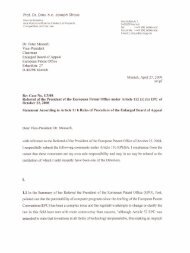Assessing the Obstacles to Industrialisation: The ... - Innovation
Assessing the Obstacles to Industrialisation: The ... - Innovation
Assessing the Obstacles to Industrialisation: The ... - Innovation
Create successful ePaper yourself
Turn your PDF publications into a flip-book with our unique Google optimized e-Paper software.
14 Stephen H. Haberit owned and operated its own haciendas, where <strong>the</strong> trees were grown, ranits own mechanical wood-pulp plant, generated its own hydroelectricpower, and operated its own railroad. <strong>The</strong> <strong>to</strong>tal number of workers in allof <strong>the</strong>se operations is unknown, but in its two paper mills alone 2,000operatives were employed. <strong>The</strong> <strong>to</strong>tal paid-in capital was 7 million pesos,and annual production was roughly three times that of all its smallcompeti<strong>to</strong>rs combined - roughly I 2 <strong>to</strong>ns of paper per day. In fact, withina decade of its founding, San Rafael eliminated almost all of its domesticcompetition.31In o<strong>the</strong>r capital-intensive industries, like cement, beer, dynamite andexplosives, and glass, a similar process occurred: large, highly capitalisedfirms producing for <strong>the</strong> national market replaced <strong>the</strong> numerous smallshops which had preceded <strong>the</strong>m.32 <strong>The</strong>y also began <strong>to</strong> drive foreignproducedgoods out of <strong>the</strong> market. In beer production, for example, <strong>the</strong>nation's newer, larger, firms (<strong>the</strong> Cervecerias Cuauhtemoc andMoctezuma) not only began <strong>to</strong> challenge <strong>the</strong> numerous local beerproducers, but also replaced foreign beer imports. Beer imports fell fromapproximately 3 million kilos in fiscal 1889-90 <strong>to</strong> just over joo,ooo kilosin 1910 1I, while demand for beer was rising. <strong>The</strong> CerveceriaCuauhtemoc's production alone in I 91 o was over 2 j times that of <strong>the</strong> <strong>to</strong>talvolume of imports.33In more labour-intensive manufacturing, especially in consumer nondurable~,asimilar transformation was underway. Data from <strong>the</strong> twolargest of <strong>the</strong>se industries, cot<strong>to</strong>n textiles and cigarettes, illustrate thischange best.One of <strong>the</strong> most obvious indica<strong>to</strong>rs of this change in <strong>the</strong> textile industrywas <strong>the</strong> tremendous growth in <strong>the</strong> number and size of fac<strong>to</strong>ries. At <strong>the</strong> endof <strong>the</strong> earlier period (1877) <strong>the</strong>re had been 92 cot<strong>to</strong>n mills in operation,each employing on average 2,7j 3 spindles, 98 looms and I 28 workers. ByI 89j <strong>the</strong> mills were both more numerous and larger : <strong>the</strong>re were now I 10mills in operation, employing an average 3,741 spindles, I 12 looms and207 workers. By 1910 <strong>the</strong>y were more numerous and larger still: <strong>the</strong>rewere now 123 active mills, employing j ,714 spindles, 203 looms and 260workers on average. In o<strong>the</strong>r words, not only were <strong>the</strong>re now roughly31<strong>The</strong> ,\lexzcan ?.earbook, 1908 (London, 1909), p. 539; Thhtfexican l'earbook, 1909-10(London, 191 I), p. 416; <strong>The</strong> ~tfexican I-earbook, 1912 (London, 1913), p. I 13, 126; Lenzand Gomez de Orozco, La industria paprlera, p. 83." For a more con~plete discussion of <strong>the</strong> transformation of <strong>the</strong>se industries see StephenH. Haber, Industry and Cnderdei'elopment: <strong>The</strong> lndustriali~ation of L\fexico, 1890-rpqo(Stanford, 1989), chs. 4 and 6." Calculated from data In El Economista ,\lr.uisano, 24 Ilec. 1898, p. 249; El Economista,Ifexicano, 27 July 1907, p. 360; Fernando Rosenzweig, Comercio exterior de L\fe'xico,~ X ~ ~ - I ~ I I : estaCjljticas econo'nzicas del Porjria<strong>to</strong> (Ilexico, 19ho), p. 208.





